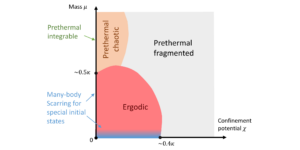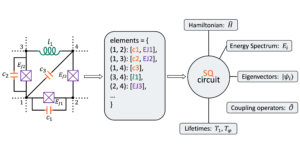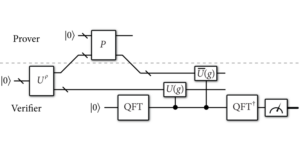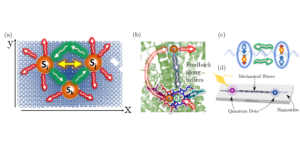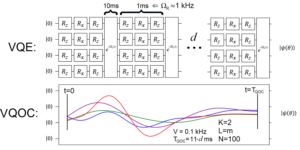1College of Science, Wuxi University, Wuxi, 214105, China
2School of Mathematics and Information Science, Henan Polytechnic University, Jiaozuo, 454000, China
Find this paper interesting or want to discuss? Scite or leave a comment on SciRate.
Abstract
In general, for a bipartite quantum system $mathbb{C}^{d}otimesmathbb{C}^{d}$ and an integer $k$ such that $4leq kle d$,there are few necessary and sufficient conditions for local discrimination of sets of $k$ generalized Bell states (GBSs) and it is difficult to locally distinguish $k$-GBS sets.The purpose of this paper is to completely solve the problem of local discrimination of GBS sets in some bipartite quantum systems.Firstly three practical and effective sufficient conditions are given,Fan$^{,}$s and Wang et al.$^{,}$s results [Phys Rev Lett 92, 177905 (2004); Phys Rev A 99, 022307 (2019)] can be deduced as special cases of these conditions.Secondly in $mathbb{C}^{4}otimesmathbb{C}^{4}$, a necessary and sufficient condition for local discrimination of GBS sets is provided, and a list of all locally indistinguishable 4-GBS sets is provided,and then the problem of local discrimination of GBS sets is completely
$mathbb{C}^{5}otimesmathbb{C}^{5}$, a concise necessary and sufficient condition for one-way local discrimination of GBS sets is obtained,which gives an affirmative answer to the case $d=5$ of the problem proposed by Wang et al.
► BibTeX data
► References
[1] C. H. Bennett, D. P. DiVincenzo, C. A. Fuchs, T. Mor, E. Rains, P. W. Shor, J. A. Smolin, and W. K. Wootters, Phys. Rev. A 59, 1070 (1999).
https://doi.org/10.1103/PhysRevA.59.1070
[2] J. Walgate, A. J. Short, L. Hardy, and V. Vedral, Phys. Rev. Lett. 85, 4972 (2000).
https://doi.org/10.1103/PhysRevLett.85.4972
[3] J. Walgate and L. Hardy, Phys. Rev. Lett. 89, 147901 (2002).
https://doi.org/10.1103/PhysRevLett.89.147901
[4] S. Ghosh, G. Kar, A. Roy, A. S. Sen (De), and U. Sen, Phys. Rev. Lett. 87, 277902 (2001).
https://doi.org/10.1103/PhysRevLett.87.277902
[5] M. Horodecki, A. Sen(De), U. Sen, and K. Horodecki, Phys. Rev. Lett. 90, 047902 (2003).
https://doi.org/10.1103/PhysRevLett.90.047902
[6] H. Fan, Phys. Rev. Lett. 92, 177905 (2004).
https://doi.org/10.1103/PhysRevLett.92.177905
[7] H. Fan, Phys. Rev. A 75, 014305 (2007).
https://doi.org/10.1103/PhysRevA.75.014305
[8] S. Ghosh, G. Kar, A. Roy, and D. Sarkar, Phys. Rev. A 70, 022304 (2004).
https://doi.org/10.1103/PhysRevA.70.022304
[9] M. Nathanson, J. Math. Phys. 46, 062103 (2005).
https://doi.org/10.1063/1.1914731
[10] Y. L. Wang, M. S. Li, S. M. Fei and Z. J. Zheng, Quant. Info. Proc. 16, 126 (2017).
https://doi.org/10.1007/s11128-017-1579-x
[11] D. P. DiVincenzo, D. W. Leung, and B. M. Terhal, IEEE Trans. Inf. Theory 48, 3 (2002).
https://doi.org/10.1109/18.985948
[12] R. Rahaman and M. G. Parker, Phys. Rev. A 91, 022330 (2015).
https://doi.org/10.1103/PhysRevA.91.022330
[13] Y. H. Yang, F. Gao, X. Wu, S. J. Qin, H. J. Zuo, and Q. Y. Wen, Sci. Rep. 5, 16967 (2015).
https://doi.org/10.1038/srep16967
[14] C. Y. Wei, T. Y. Wang, and F. Gao, Phys. Rev. A 93, 042318 (2016).
https://doi.org/10.1103/PhysRevA.93.042318
[15] C. Y. Wei, X. Q. Cai, B. Liu, T. Y. Wang, and F. Gao, IEEE Trans. Comput. 67, 1 (2018).
https://doi.org/10.1109/TC.2017.2721404
[16] M. Nathanson, Phys. Rev. A 88, 062316 (2013).
https://doi.org/10.1103/PhysRevA.88.062316
[17] S. Bandyopadhyay, S. Ghosh, and G. Kar, New J. Phys. 13, 123013 (2011).
https://doi.org/10.1088/1367-2630/13/12/123013
[18] N. K. Yu, R. Y. Duan, and M. S. Ying, Phys. Rev. Lett. 109, 020506 (2012).
https://doi.org/10.1103/PhysRevLett.109.020506
[19] Z. C. Zhang, K. Q. Feng, F. Gao and Q. Y. Wen, Phys. Rev. A 91, 012329 (2015).
https://doi.org/10.1103/PhysRevA.91.012329
[20] Y. L. Wang, M. S. Li, Z. J. Zheng and S. M. Fei, Quant. Info. Proc. 15, 1661 (2016).
https://doi.org/10.1007/s11128-016-1243-x
[21] Y. H. Yang, J. T. Yuan, C. H. Wang and S. J. Geng, Phys. Rev. A 98, 042333 (2018).
https://doi.org/10.1103/PhysRevA.98.042333
[22] J. T. Yuan, C. H. Wang, Y. H. Yang and S. J. Geng, Quant. Info. Proc. 18, 145 (2019).
https://doi.org/10.1007/s11128-019-2257-y
[23] Y. L. Wang, M. S. Li and Z. X. Xiong, Phys. Rev. A 99, 022307 (2019).
https://doi.org/10.1103/PhysRevA.99.022307
[24] G. J. Tian, S. X. Yu, F. Gao, Q. Y. Wen and C. H. Oh, Phys. Rev. A 91, 052314 (2015).
https://doi.org/10.1103/PhysRevA.91.052314
[25] Y. H. Yang, G. F. Mu, J. T. Yuan and C. H. Wang, Quant. Info. Proc. 20, 52 (2021).
https://doi.org/10.1007/s11128-021-02990-9
[26] Y. H. Yang, C. H. Wang, J. T. Yuan, X. Wu and H. J. Zuo, Quant. Inf. Process. 17, 29 (2018).
https://doi.org/10.1007/s11128-017-1797-2
[27] D. Petz, “Quantum Information Theory and Quantum Statistics”, Springer, (2006).
https://doi.org/10.1007/978-3-540-74636-2
[28] J. T. Yuan, Y. H. Yang and C. H. Wang, J. Phys. A: Math. Theor. 53, 505304 (2020).
https://doi.org/10.1088/1751-8121/abc43b
[29] C. H. Wang, J. T. Yuan, Y. H. Yang and G. F. Mu, J. Math. Phys. 62, 032203 (2021).
https://doi.org/10.1063/5.0029164
[30] G. J. Tian, S. X. Yu, F. Gao, Q. Y. Wen and C. H. Oh, Phys. Rev. A 94, 052315 (2016).
https://doi.org/10.1103/PhysRevA.94.052315
[31] B. J. Wu, J. Q. Jiang, J. L. Jiang, G. J. Tian and S. X. Ming, Phys. Rev. A 98, 022304 (2018).
https://doi.org/10.1103/PhysRevA.98.022304
[32] E. Hostens, J. Dehaene and B. De Moor, Phys. Rev. A 71, 042315 (2005).
https://doi.org/10.1103/PhysRevA.71.042315
[33] J. M. Farinholt, J. Phys. A: Math. Theor. 47, 305303 (2014).
https://doi.org/10.1088/1751-8113/47/30/305303
[34] S. X. Yu and C. H. Oh, arXiv: 1502.01274.
https://doi.org/10.48550/arXiv.1502.01274
Cited by
[1] Mao-Sheng Li, Fei Shi, and Yan-Ling Wang, “Local discrimination of generalized Bell states via commutativity”, Physical Review A 105 3, 032455 (2022).
The above citations are from SAO/NASA ADS (last updated successfully 2022-07-29 14:39:08). The list may be incomplete as not all publishers provide suitable and complete citation data.
On Crossref’s cited-by service no data on citing works was found (last attempt 2022-07-29 14:39:07).
This Paper is published in Quantum under the Creative Commons Attribution 4.0 International (CC BY 4.0) license. Copyright remains with the original copyright holders such as the authors or their institutions.







